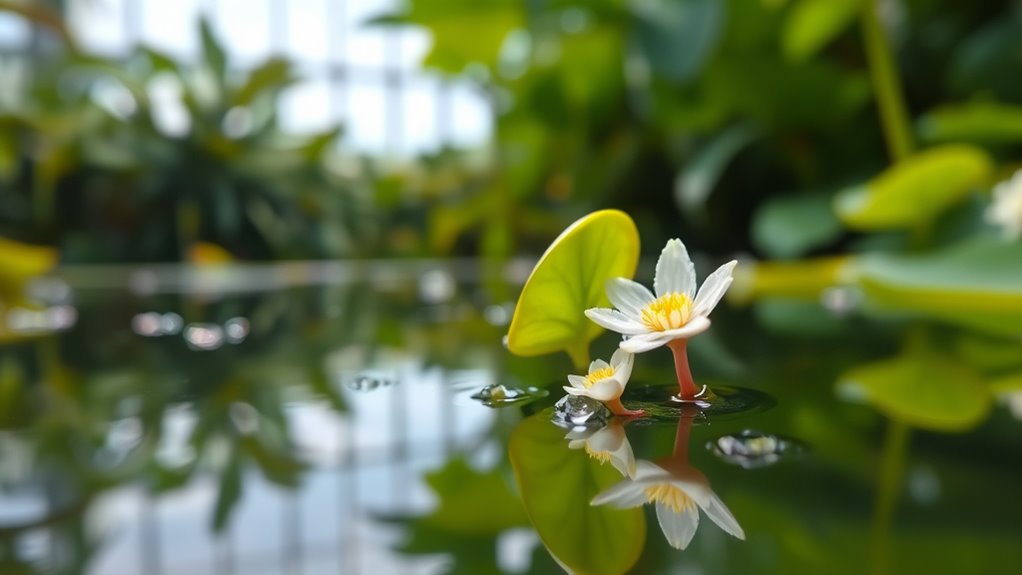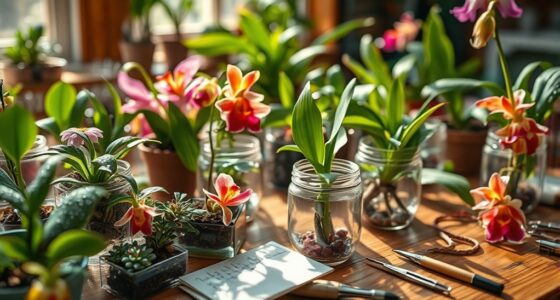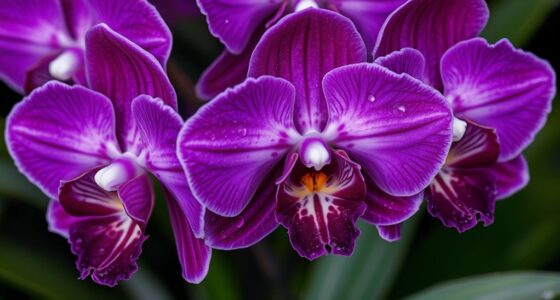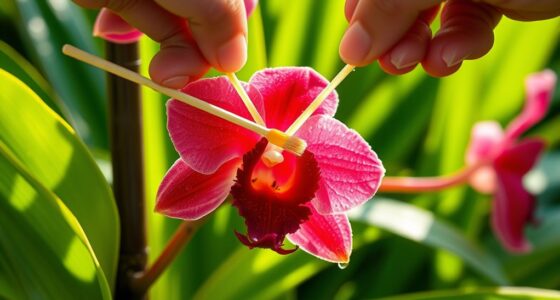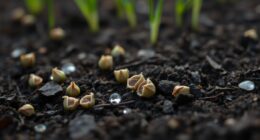Kew Gardens saved the world’s smallest water lily from extinction through dedicated conservation efforts. They used specialized techniques to cultivate and propagate this delicate plant in controlled environments, studying its growth and reproductive methods. These scientific strategies helped guarantee its survival and expanded its populations. Their work highlights the importance of protecting rare species and understanding plant adaptation. If you want to discover how these efforts made a lasting difference, keep exploring this remarkable story.
Key Takeaways
- Kew Gardens cultivated and propagated the tiny water lily in controlled environments to prevent extinction.
- They employed specialized techniques based on research into the plant’s growth, habitat, and reproduction.
- Conservation efforts included developing strategies for nurturing and expanding the lily’s populations.
- Scientific studies provided insights into plant adaptation, resilience, and evolutionary processes.
- Public support and awareness helped fund ongoing research and emphasized the importance of conserving rare species.

The world’s smallest water lily is a tiny marvel that captivates botanists and nature enthusiasts alike. Its delicate size and unique characteristics make it a true wonder of the plant kingdom. But despite its beauty, this water lily faced the threat of extinction, making conservation efforts essential for its survival. Recognizing its botanical significance, experts and institutions like Kew Gardens stepped in to protect and preserve this extraordinary species. The efforts weren’t just about saving a plant; they were about safeguarding a piece of botanical history that offers insights into plant adaptation and evolution.
The world’s smallest water lily faces extinction, highlighting the importance of conservation and botanical preservation efforts.
Kew Gardens played a pivotal role in the conservation of this water lily, employing specialized techniques to cultivate and propagate it in controlled environments. This was no simple task, considering its minuscule size and specific habitat requirements. By establishing a dedicated conservation program, Kew Gardens ensured that the water lily could be bred and grown outside its natural habitat, reducing the risk of extinction. Their work involved detailed scientific research, including studying its growth cycle, habitat preferences, and reproductive methods. This knowledge helped them develop effective strategies to nurture and expand the population, ultimately securing its future. Additionally, their efforts contributed to understanding plant adaptation, revealing how species evolve to thrive in limited or specialized environments.
The botanical significance of this tiny water lily extends beyond its size. It offers valuable insights into plant adaptation, especially how certain species evolve to survive in limited or specialized environments. Its delicate structure and growth patterns reveal important clues about aquatic plant resilience and evolutionary history. For botanists, understanding this tiny species enriches our broader knowledge of plant biodiversity and conservation biology. It also underscores the importance of protecting rare and endangered species before they vanish, taking with them unique genetic traits that could be crucial for future scientific discoveries.
Your involvement in conservation efforts can make a difference. Support for organizations like Kew Gardens helps fund ongoing research and habitat preservation projects. By raising awareness about the importance of conserving such species, you contribute to a global effort to protect botanical diversity. The story of this tiny water lily demonstrates that even the smallest plants can have profound botanical significance. It reminds us that conservation isn’t just about saving individual species; it’s about maintaining the intricate web of life that sustains our planet. Through dedicated efforts, collaborations, and awareness, we can ensure that this tiny marvel continues to inspire future generations and serve as a symbol of successful conservation.
Frequently Asked Questions
How Long Does the Water Lily Typically Live?
You might wonder how long this tiny water lily lives, and its lifespan duration typically ranges from a few months to about a year. During its aging process, it blooms quickly and produces seeds to guarantee survival. The plant’s short lifespan is balanced by its rapid growth and reproduction. Proper care and ideal conditions can extend its life slightly, but overall, it’s designed for a brief, vibrant existence.
Can the Lily Survive in Different Climates?
Did you know that the world’s smallest water lily can survive in various climates? This plant demonstrates remarkable climatic adaptability and habitat resilience, allowing it to thrive beyond its native tropical environment. You can find it flourishing in diverse conditions, thanks to its ability to adjust to different temperature ranges and water qualities. Its resilience guarantees it remains a fascinating species, even when faced with changing environmental factors.
What Specific Conservation Methods Did Kew Gardens Use?
Kew Gardens used ex situ conservation by cultivating the lily in their controlled environment, ensuring its survival outside its natural habitat. They also focused on habitat restoration to improve conditions in the wild, helping the lily thrive naturally again. These combined efforts protect the species from extinction, allowing it to flourish both in cultivation and in restored natural settings. Your support for such conservation methods can make a real difference.
Are There Any Ongoing Threats to Its Habitat?
While the habitat of the tiny water lily remains relatively protected, you should be aware of ongoing threats like habitat destruction and invasive species. These issues can quickly erode its environment, risking its survival. Kew Gardens continues monitoring and advocating for conservation, but your awareness and support are crucial to combat these threats. Without proactive efforts, even this small species faces the danger of losing its fragile habitat forever.
How Does the Lily Reproduce in the Wild?
You might be surprised to learn that the lily reproduces through pollination techniques like insect pollination, where tiny bees or flies transfer pollen between flowers. After pollination, seed dispersal methods such as water currents carry the seeds to new locations, helping the lily spread naturally. This combination guarantees its survival in the wild, although ongoing threats to its habitat mean conservation efforts are still essential for its future.
Conclusion
Thanks to Kew Gardens, you’ve witnessed how tiny yet powerful a water lily can be. Their efforts didn’t just save a plant; they preserved a miracle of nature’s resilience. This little water lily shows that even the smallest creatures hold worlds of wonder within them. If we keep caring and acting, we can prevent extinction on a scale that’s almost impossible to imagine. Your support can be the spark that saves countless other miracles in the making.

